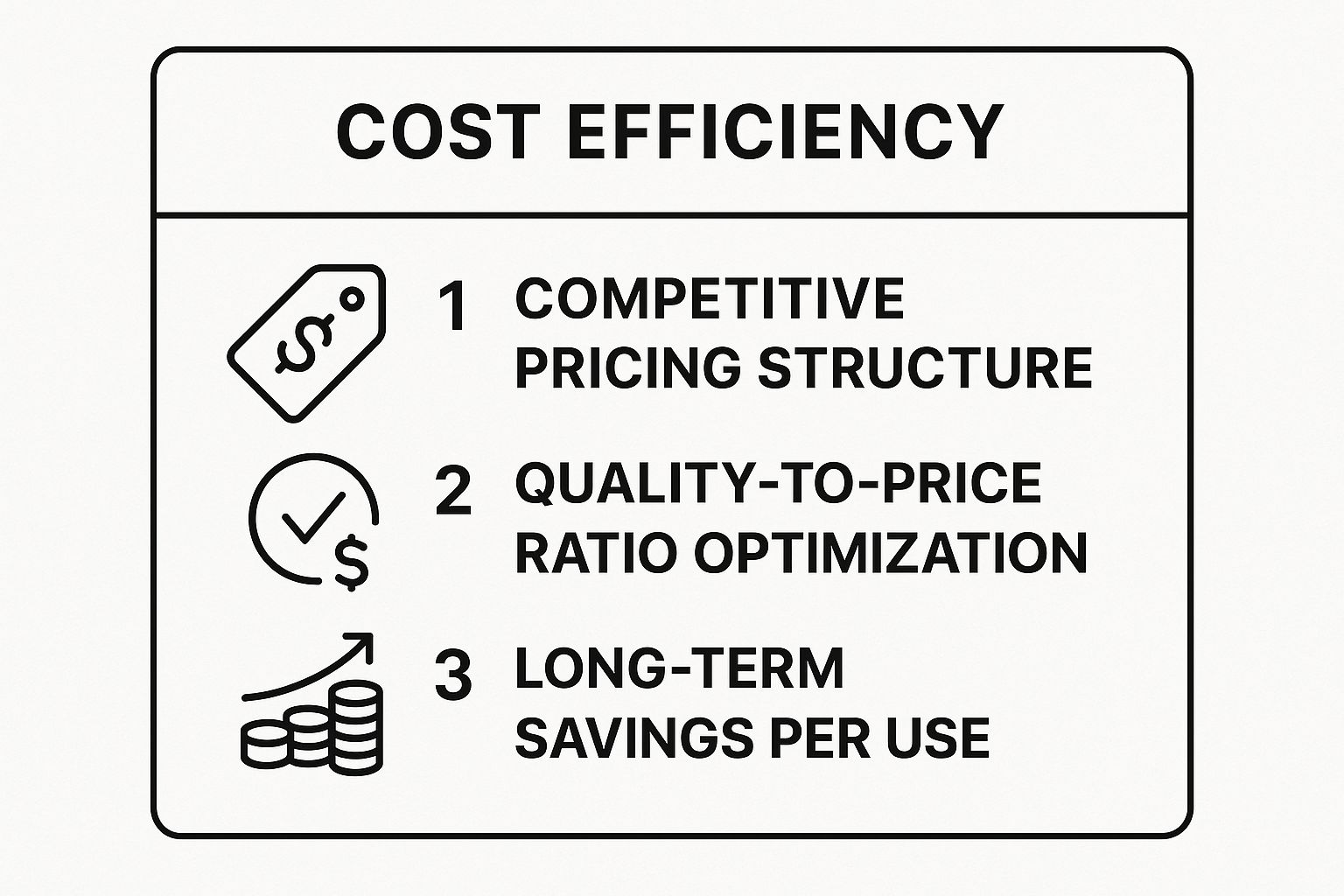8 Powerful Brand Positioning Strategies for 2025
In a saturated market, standing out isn't just an advantage; it's a necessity. Effective brand positioning is the strategic act of carving out a distinct and memorable space in the minds of your target audience. It’s the difference between being 'just another option' and becoming 'the only choice.' But with so many potential paths, how do you choose the right one?
This guide moves beyond theory to provide a clear, actionable roadmap. We will break down eight powerful brand positioning strategies that successful companies use to dominate their niches and build lasting customer loyalty. From leveraging premium quality to championing social causes, each strategy offers a unique angle to connect with your ideal customer. To truly define your unshakeable place in the market, it's essential to understand how to create strong brand guidelines that articulate your brand's mission, vision, and core values.
By exploring real-world examples from innovators like Tesla and customer-centric leaders like Zappos, you will gain the insights needed to select and implement the best approach for your business. Let's explore the frameworks that will help you define your unique identity, build a brand that resonates, and turn casual buyers into dedicated advocates.
1. Value-Based Positioning
Value-based positioning is one of the most effective brand positioning strategies for capturing a specific market segment: the practical, budget-conscious consumer. This strategy hinges on delivering the best possible value by striking a deliberate balance between quality and price. It’s not about being the cheapest option, but about being the smartest choice for customers who want reliable quality without a premium price tag.
Brands that master this approach, like IKEA and Trader Joe's, build a reputation for cost-effectiveness and dependability. They streamline their operations, from supply chain to marketing, to pass savings onto the customer. This creates a powerful perception that choosing their brand is a financially savvy decision, building long-term trust with a price-sensitive audience.
How to Implement This Strategy
To succeed with value-based positioning, your entire business model must support the claim. This involves more than just competitive pricing; it requires deep operational efficiency.
- Optimize Your Operations: Constantly refine your supply chain, production, and distribution to reduce overhead. Costco's bulk purchasing model and IKEA's flat-pack furniture are perfect examples of operational choices that directly support lower prices.
- Communicate Savings Clearly: Don't just say you offer great value; prove it. Use clear, tangible numbers and comparisons in your marketing. Target’s slogan, "Expect More. Pay Less," is a direct and powerful value promise.
- Maintain Quality Consistency: Your value proposition falls apart if quality is inconsistent. Your product or service must reliably meet a certain standard to justify the price. Southwest Airlines built its brand on offering no-frills, yet consistently reliable and friendly, air travel.
This summary highlights the core pillars of a successful value-based model.

As the infographic illustrates, the focus is on a sustainable model where competitive pricing is supported by an optimized quality-to-price ratio, ultimately delivering long-term savings. Crafting the right financial structure is crucial, and a well-defined pricing model is the first step. For more guidance on this, you can learn more about how to structure your pricing model here. By building your strategy around these core tenets, you can carve out a strong market position that resonates with practical consumers.
2. Quality-Based Positioning
Quality-based positioning is a premium strategy centered on establishing a brand as the superior choice through exceptional product craftsmanship, performance, and durability. This approach targets discerning consumers who prioritize excellence and are willing to pay more for it. The focus shifts from price to meticulous attention to detail, high-grade materials, and unmatched performance.
Brands like Rolex and Sub-Zero master this by building their entire identity around superior engineering and longevity. They don't compete on price; they compete on being the absolute best in their category. This creates a powerful perception of prestige and reliability, attracting a loyal customer base that values long-term quality over short-term savings.

How to Implement This Strategy
Successfully implementing quality-based positioning requires an unwavering commitment to excellence that is evident in every facet of your business. Your brand story and marketing must be backed by tangible proof of superiority.
- Showcase Your Craftsmanship: Go beyond simply stating your product is high-quality. Document and share your quality control processes, the story behind your materials, and the expertise of your team. Patagonia’s marketing often highlights the durability of its gear and its lifetime repair promise.
- Leverage Third-Party Validation: Use objective proof to reinforce your claims. Earn industry certifications, publish positive results from independent testing, and prominently display awards. Dyson frequently uses scientific data and engineering diagrams to prove its vacuum cleaners' superior suction.
- Invest in Post-Sale Experience: A premium product deserves premium service. Exceptional after-sales support, warranties, and repair services reinforce the customer's belief that they made a high-quality purchase. Mercedes-Benz’s slogan, “The Best or Nothing,” extends to its world-class customer service and dealership experience.
This summary outlines the core elements needed to build a brand synonymous with quality.
As the infographic shows, the foundation of this brand positioning strategy is a commitment to superior components and processes that result in a market-leading product. This builds brand equity and justifies a premium price point. For a deeper look into building a brand that customers love, you can explore more on creating a strong brand identity here. By weaving quality into your brand’s DNA, you can cultivate a reputation for excellence that transcends price competition.
3. Differentiation Positioning
Differentiation positioning carves out a unique market space by highlighting features, benefits, or experiences that competitors cannot easily replicate. This strategy is built on innovation and a strong unique selling proposition (USP), making your brand the only viable choice for customers seeking specific qualities. It moves the conversation away from price and toward distinct value.

Brands that excel at this, like Apple and Tesla, become synonymous with their unique attributes. Apple's focus on elegant design, ecosystem integration, and user experience sets it apart, while Tesla dominates with its cutting-edge electric performance and autonomous driving technology. This approach makes direct comparisons difficult and cultivates a loyal following that values what makes the brand special.
How to Implement This Strategy
Successful differentiation requires a deep understanding of customer needs and a commitment to innovation that your audience truly values. It's about being different in a way that matters.
- Identify a Meaningful Difference: Your point of differentiation must solve a problem or fulfill a desire better than anyone else. Warby Parker's home try-on program directly addressed the biggest pain point of buying glasses online, creating an unmatched convenience.
- Communicate Your Uniqueness Consistently: Every touchpoint, from marketing to product design, must reinforce what makes you different. Lush consistently emphasizes its fresh, handmade cosmetics and ethical sourcing, which is evident in its store experience, packaging, and campaigns.
- Protect Your Differentiators: If possible, protect your unique features through patents, trademarks, or proprietary technology. This creates a sustainable competitive advantage and prevents copycats from eroding your market position. Dollar Shave Club’s disruptive subscription model was its key differentiator early on.
This summary highlights the core pillars of a successful differentiation model. By focusing on a unique and valuable proposition, you can create a brand that stands alone in a crowded market.
4. Customer Service Positioning
Customer service positioning is a powerful strategy that builds a brand’s entire identity around delivering an unparalleled customer experience. This approach goes beyond standard support, making exceptional service the primary competitive advantage. Brands using this strategy focus on responsiveness, personalization, and proactive problem-solving to create fiercely loyal customers who become brand advocates.
Companies that excel at this, like Zappos and Chewy, understand that every interaction is a brand-building opportunity. They make service excellence their core differentiator, turning potentially negative experiences into moments of delight. This fosters an emotional connection with the customer, making them feel valued and understood, which is often more compelling than price or product features alone.
How to Implement This Strategy
Successfully positioning your brand around customer service requires a company-wide commitment, not just a well-trained support team. It must be woven into your culture.
- Empower Your Employees: Give your team the autonomy to solve customer problems on the spot. Ritz-Carlton famously empowers employees with a discretionary budget to resolve guest issues, ensuring swift and satisfactory outcomes without managerial red tape.
- Invest in a Feedback Loop: Actively measure customer satisfaction with tools like Net Promoter Score (NPS) and use the feedback to drive real improvements. Respond to complaints publicly and transparently to show you are listening and committed to getting it right.
- Design Proactive Service Protocols: Don't just react to problems; anticipate them. Chewy’s practice of sending handwritten sympathy cards to customers who have lost a pet is a legendary example of proactive, empathetic service that builds a lasting bond.
This summary highlights the core pillars of a successful customer-centric model.
By making service a core tenet of your brand, you create a moat that competitors find difficult to cross. It starts from the very first interaction. For more guidance on this, you can learn more about how to create a great initial experience with customer onboarding strategies. Building your strategy around these principles allows you to cultivate a reputation that transcends the product itself, creating a loyal and profitable customer base.
5. Convenience-Based Positioning
Convenience-based positioning centers on one core promise: making the customer's life easier. This strategy appeals directly to time-starved consumers who prioritize speed, accessibility, and simplicity above all else. Brands using this approach focus relentlessly on removing friction from the customer journey, optimizing every touchpoint to require the least amount of effort from the user.

In a world where time is a luxury, convenience is the ultimate currency. Brands like Amazon Prime, with its one-click ordering and fast shipping, or Uber, which provides on-demand transportation, have built empires on this principle. They don't just sell a product or service; they sell time back to their customers. This focus on seamless, effortless experiences is a powerful differentiator that builds immense customer loyalty and justifies a premium price.
How to Implement This Strategy
Successfully positioning your brand around convenience requires a deep, empathetic understanding of your customer's daily struggles and a commitment to solving them through operational excellence.
- Map the Customer Journey: Analyze every single step a customer takes to interact with your brand, from discovery to purchase and beyond. Identify every point of friction, delay, or unnecessary effort and brainstorm ways to eliminate it.
- Invest in Technology: Leverage technology to streamline processes. This could be an intuitive mobile app, an automated checkout system, or a subscription model that removes the need for repeat purchases. Netflix's instant streaming platform is a prime example of technology enabling ultimate convenience.
- Prioritize Speed and Accessibility: Your service must be fast and readily available. McDonald's mastered this with its drive-through model and consistent global presence. Measure and continuously optimize for speed, whether it's delivery time, customer service response, or website load speed.
This summary highlights how to execute convenience-based brand positioning strategies effectively.
As the infographic shows, the strategy is built on a foundation of effortless transactions and accessibility, which directly translates to time saved for the customer. This approach requires significant investment in logistics, technology, and user experience design. A key part of this is ensuring your platform can handle demand smoothly. To ensure your digital presence is up to the task, consider exploring scalable web hosting solutions that can grow with your user base. By making your customer's life easier, you create an indispensable brand they will return to again and again.
6. Niche/Specialist Positioning
Niche or specialist positioning is one of the most powerful brand positioning strategies for businesses aiming to dominate a specific, well-defined market segment. Instead of trying to appeal to everyone, this strategy focuses on serving a narrow audience with specialized needs better than any generalist competitor. It involves becoming the definitive authority in a particular area, whether it's a product category, a customer type, or a unique problem.
Brands that successfully implement this strategy, like Yeti with its premium coolers for outdoor enthusiasts or CarMax with its streamlined used-car buying experience, trade broad appeal for deep relevance. They build an intensely loyal following by speaking directly to the unique pain points and passions of their target audience, creating a defensible market position that larger competitors often overlook or cannot replicate authentically.
How to Implement This Strategy
To succeed with niche positioning, you must commit to serving your chosen segment with unparalleled focus and expertise. This requires a deep understanding of your audience and a disciplined approach to growth.
- Deeply Understand Audience Pain Points: Go beyond surface-level demographics. Conduct in-depth research, interviews, and community engagement to uncover the specific challenges, desires, and language of your niche. Purple, for example, didn't just sell mattresses; it addressed the specific sleep needs of people seeking pressure relief.
- Become an Educational Resource: Establish authority by creating content that educates and empowers your audience. REI does this masterfully through its expert advice, workshops, and content tailored to outdoor recreation. This builds trust and makes your brand synonymous with the niche itself.
- Build a Strong Community: A niche audience often shares a strong sense of identity. Foster this by creating platforms for connection, encouraging user-generated content, and highlighting customer stories. CrossFit built a global movement by turning its fitness methodology into a community-driven lifestyle.
This summary highlights the core pillars of a successful niche-focused model. By resisting the temptation to expand too quickly and instead doubling down on serving your core audience, you can build a highly profitable and loyal customer base. The key is to own your space completely, becoming the only logical choice for a specific group of people.
7. Innovation/Technology Leadership Positioning
Innovation and technology leadership positioning establishes a brand as the cutting-edge, forward-thinking leader in its category. This strategy centers on being first-to-market with new technologies, pioneering novel solutions, and continuously pushing the boundaries of what's possible. It attracts early adopters and customers who equate the brand with progress and want to be at the forefront of advancement.
Brands that successfully use this strategy, like Apple and SpaceX, cultivate a perception of being perpetually one step ahead of the competition. They invest heavily in research and development to create revolutionary products, building an identity synonymous with invention. This approach creates a powerful moat, making it difficult for competitors to catch up and justifying premium pricing for their groundbreaking offerings.
How to Implement This Strategy
To position your brand as an innovation leader, you must embed a culture of invention and experimentation into your company's DNA. It requires a long-term commitment to research and a tolerance for the risks that come with exploring uncharted territory.
- Commit to R&D: Allocate a significant portion of your revenue (often 15-20%) to research and development. Brands like Nvidia do this to maintain their leadership in GPU technology for gaming and AI, ensuring they always have the next big thing in the pipeline.
- Protect Your Innovations: Actively file patents to protect your intellectual property. This not only safeguards your unique technology but also legally solidifies your position as the originator of an idea or product, as seen with pioneers like Boston Dynamics in robotics.
- Communicate Your Vision: Build excitement and anticipation by sharing your innovation roadmap. Teasing future developments, as Apple famously does, keeps your audience engaged and reinforces your brand's forward-thinking identity. Balance game-changing "moonshots" with consistent, incremental improvements to maintain momentum.
This summary outlines the core elements of a successful innovation leadership model.
As this video on disruptive innovation explains, true leadership involves creating new markets or reshaping existing ones. This strategy is not just about having better features; it’s about redefining the entire product category. For more insights on how to foster this mindset, you can learn more about building an innovation culture. By making innovation the heart of your brand, you can build a powerful and defensible market position that competitors struggle to replicate.
8. Social Responsibility/Purpose-Driven Positioning
Purpose-driven positioning moves a brand's mission beyond profit, centering its identity around a commitment to social, ethical, or environmental causes. This strategy connects with a growing segment of consumers who want their purchases to reflect their values and contribute to positive change. The brand isn't just selling a product; it's offering a way to participate in a meaningful cause.
Brands that successfully adopt this approach, such as Patagonia and TOMS, weave their purpose into the fabric of their identity. Patagonia's environmental activism and TOMS's "One for One" giving model are not just marketing campaigns; they are core business principles. This authenticity builds deep loyalty with consumers who see the brand as a partner in creating a better world, making it one of the most resonant brand positioning strategies available today.
How to Implement This Strategy
To succeed with purpose-driven positioning, your commitment must be genuine and integrated into every aspect of your operations. Authenticity is non-negotiable, as consumers are quick to spot "virtue signaling" that lacks real substance.
- Embed Your Purpose Authentically: Your social mission cannot be an afterthought. It must influence your supply chain, product development, company culture, and marketing. Ben & Jerry's long-standing advocacy for social justice is a prime example of a purpose that permeates the entire organization.
- Be Transparent and Report Impact: Don't just state your mission; prove your impact. Transparently share data on your initiatives, donations, or environmental footprint. This builds trust and demonstrates a real commitment beyond marketing claims.
- Take a Stand and Be Consistent: A purpose-driven brand must be prepared to stand for its beliefs, even if it proves controversial. Consistency in your actions and messaging reinforces your brand's integrity and strengthens your connection with your target audience.
This summary highlights the core pillars of a successful purpose-driven model.
As the infographic shows, the focus is on building a brand where authentic purpose drives consumer loyalty and positive impact. Communicating this mission effectively requires a dedicated approach and the right tools. For startups looking to build their brand around a cause, you can explore some of the top startup marketing tools on pages.report. By genuinely integrating a powerful mission into your business, you can create a brand that not only succeeds but also makes a difference.
Brand Positioning Strategies Comparison Table
| Positioning Strategy | Implementation Complexity 🔄 | Resource Requirements ⚡ | Expected Outcomes 📊 | Ideal Use Cases 💡 | Key Advantages ⭐ |
|---|---|---|---|---|---|
| Value-Based Positioning | Moderate 🔄🔄 | Moderate ⚡⚡ | Cost-effective value delivery 📊📊 | Budget-conscious consumers, broad market | Appeals to price-sensitive market, easy to communicate |
| Quality-Based Positioning | High 🔄🔄🔄 | High ⚡⚡⚡ | Premium quality perception & loyalty ⭐⭐ | Premium segments valuing craftsmanship and durability | Higher margins, strong brand loyalty |
| Differentiation Positioning | High 🔄🔄🔄 | High ⚡⚡⚡ | Unique market position, loyal niche 📊⭐ | Innovation-driven, unique product or service features | Reduces price competition, sustainable advantage |
| Customer Service Positioning | High 🔄🔄🔄 | High ⚡⚡⚡ | Strong emotional connections, lower churn ⭐⭐ | Service-oriented industries, highly competitive markets | Builds loyalty, differentiates in commoditized fields |
| Convenience-Based Positioning | Moderate to High 🔄🔄🔄 | High ⚡⚡⚡ | Faster transactions, higher purchase frequency 📊⚡ | Time-sensitive consumers, tech-enabled services | Increases purchase frequency, scalable with technology |
| Niche/Specialist Positioning | Moderate 🔄🔄 | Moderate ⚡⚡ | Deep relevance in narrow market, strong loyalty 📊⭐ | Specialized markets, startups, and small businesses | Less competition, higher margins |
| Innovation/Technology Leadership | Very High 🔄🔄🔄🔄 | Very High ⚡⚡⚡⚡ | Market leadership, media buzz, premium pricing ⭐⭐ | High-tech, fast-evolving industries | Creates barriers, attracts early adopters |
| Social Responsibility/Purpose-Driven | Moderate to High 🔄🔄🔄 | Moderate to High ⚡⚡⚡ | Emotional connection, ethical brand image ⭐⭐ | Values-driven consumers, conscious markets | Differentiates through mission, attracts loyal base |
Choosing Your Position and Winning the Market
We've explored a powerful spectrum of brand positioning strategies, from the uncompromising standards of Quality-Based Positioning to the disruptive force of Innovation Leadership. Each path offers a distinct way to carve out a meaningful and profitable space in the minds of your audience. Whether you choose to dominate through unparalleled convenience like Amazon, champion a specific community with Niche Positioning, or lead with a powerful purpose like Patagonia, the core principle remains the same: positioning is the art of intentional sacrifice. You cannot be everything to everyone.
The journey to effective brand positioning is not a one-time setup; it's a continuous process of reinforcement and adaptation. The strategies you choose today must be reflected in every aspect of your business tomorrow. This includes your product roadmap, your marketing copy, your customer support interactions, and even your internal company culture. Consistency is what transforms a positioning statement from a mere concept on a whiteboard into a tangible, lived experience for your customers.
From Strategy to Action: Your Next Steps
The most successful brands often combine elements from multiple approaches, but they always have a single, dominant strategy that acts as their North Star. To put these ideas into practice, start with a rigorous internal and external audit.
- Analyze Your Core Competencies: What does your team or product do better than anyone else? Is it your engineering prowess (Innovation), your empathetic support team (Customer Service), or your efficient operations (Convenience)? Be honest about your strengths.
- Deeply Understand Your Audience: Move beyond basic demographics. What are their core pains, unmet needs, and deepest values? Your chosen position must resonate with what they truly care about.
- Evaluate the Competitive Landscape: Where are the gaps in the market? Perhaps your competitors are all focused on features, leaving a wide-open opportunity for a brand built on exceptional customer service or social responsibility.
By aligning your authentic brand strengths with a genuine market need, you create a defensible position that transcends a simple feature-for-feature comparison. You build a brand that customers choose not just for what it does, but for what it represents. To gain a broader perspective on the various approaches, consider this detailed look at 8 types of positioning strategies for B2B products, which offers additional context for business-to-business applications.
Ultimately, mastering these brand positioning strategies is about creating clarity. It provides a filter for every decision you make, ensuring that each action you take moves you closer to becoming the undeniable best choice for a specific type of customer. This clarity not only attracts the right audience but also empowers your team to build, market, and sell with unified purpose and conviction.
Ready to translate your brand positioning strategy into a high-converting landing page? Pages.Report analyzes the world's best SaaS landing pages, giving you actionable insights and proven design patterns to communicate your unique value proposition effectively. See how top companies implement their positioning and build your next great page with confidence at Pages.Report.
